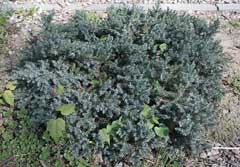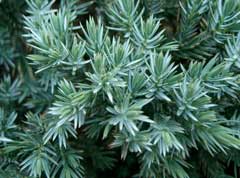 |
|
http://commons.wikimedia.org/wiki/User:Pleple2000 |
 |
| http://commons.wikimedia.org/wiki/User:KENPEI |
Translate this page:
Summary
Form: Irregular or sprawling, Prostrate, Pyramidal, Spreading or horizontal, Upright or erect.
Physical Characteristics

 Juniperus squamata is an evergreen Shrub growing to 4 m (13ft) by 5 m (16ft) at a slow rate.
Juniperus squamata is an evergreen Shrub growing to 4 m (13ft) by 5 m (16ft) at a slow rate.
See above for USDA hardiness. It is hardy to UK zone 5. It is in leaf all year, and the seeds ripen in October. The species is dioecious (individual flowers are either male or female, but only one sex is to be found on any one plant so both male and female plants must be grown if seed is required). and is pollinated by Wind. The plant is not self-fertile.
Suitable for: light (sandy), medium (loamy) and heavy (clay) soils and prefers well-drained soil. Suitable pH: mildly acid, neutral and basic (mildly alkaline) soils and can grow in very alkaline soils.
It cannot grow in the shade. It prefers dry or moist soil and can tolerate drought.
UK Hardiness Map
US Hardiness Map
Synonyms
J. recurva squamata.
Plant Habitats
Woodland Garden Sunny Edge; Ground Cover;
Edible Uses
References More on Edible Uses
Medicinal Uses
Plants For A Future can not take any responsibility for any adverse effects from the use of plants. Always seek advice from a professional before using a plant medicinally.
Skin
The powdered plant is soaked for half an hour in water and then used for washing skin diseases[272].
References More on Medicinal Uses
The Bookshop: Edible Plant Books
Our Latest books on Perennial Plants For Food Forests and Permaculture Gardens in paperback or digital formats.

Edible Tropical Plants
Food Forest Plants for Hotter Conditions: 250+ Plants For Tropical Food Forests & Permaculture Gardens.
More

Edible Temperate Plants
Plants for Your Food Forest: 500 Plants for Temperate Food Forests & Permaculture Gardens.
More

More Books
PFAF have eight books available in paperback and digital formats. Browse the shop for more information.
Shop Now
Other Uses
Fuel Incense Wood
The cultivar 'Blue Carpet' can be used as a ground cover plant in a sunny position[188]. The wood is very fragrant, it is used as a fuel and an incense[51, 158, 272]. The leaves are used as incense[272].
Special Uses
Ground cover
References More on Other Uses
Cultivation details
Landscape Uses:Cascades, Erosion control, Ground cover, Massing, Rock garden. Succeeds in most soils if they are well drained, preferring a neutral or slightly alkaline soil[1, 11] and succeeding on chalk[200]. A drought tolerant plant once established, succeeding in hot dry positions[200]. This species is closely allied to J. recurva[11]. There are many named forms, selected for their ornamental value[188]. The type species is very slow growing in Britain[185] but the cultivar 'Meyeri' is somewhat faster and more successful. Dioecious. Male and female plants must be grown if seed is required. Special Features:Attractive foliage, Fragrant foliage, Not North American native, There are no flowers or blooms.
References Carbon Farming Information and Carbon Sequestration Information
Temperature Converter
Type a value in the Celsius field to convert the value to Fahrenheit:
Fahrenheit:
The PFAF Bookshop
Plants For A Future have a number of books available in paperback and digital form. Book titles include Edible Plants, Edible Perennials, Edible Trees,Edible Shrubs, Woodland Gardening, and Temperate Food Forest Plants. Our new book is Food Forest Plants For Hotter Conditions (Tropical and Sub-Tropical).
Shop Now
Plant Propagation
The seed requires a period of cold stratification. The seed has a hard seedcoat and can be very slow to germinate, requiring a cold period followed by a warm period and then another cold spell, each of 2 - 3 months duration[78, 81]. Soaking the seed for 3 - 6 seconds in boiling water may speed up the germination process[11]. The seed is best sown as soon as it is ripe in a cold frame. Some might germinate in the following spring, though most will take another year. Another possibility is to harvest the seed 'green' (when the embryo has fully formed but before the seedcoat has hardened). The seedlings can be potted up into individual pots when they are large enough to handle. Grow on in pots until large enough, then plant out in early summer. When stored dry, the seed can remain viable for several years[1]. Cuttings of mature wood, 5 - 10cm with a heel, September/October in a cold frame. Plant out in the following autumn[1, 78]. Layering in September/October. Takes 12 months[78].
Other Names
If available other names are mentioned here
Native Range
TEMPERATE ASIA: Afghanistan, China (Anhui Sheng, Fujian Sheng, Gansu Sheng (south), Guizhou Sheng, Hubei Sheng (west), Shaanxi Sheng (south), Sichuan Sheng, Xizang Zizhiqu (west), Yunnan Sheng), Taiwan TROPICAL ASIA: Bhutan, India (north), Nepal, Pakistan (north), Myanmar (north)
Weed Potential
Right plant wrong place. We are currently updating this section.
Please note that a plant may be invasive in one area but may not in your area so it's worth checking.
Conservation Status
IUCN Red List of Threatened Plants Status :

| Related Plants
|
| Latin Name | Common Name | Habit | Height | Hardiness | Growth | Soil | Shade | Moisture | Edible | Medicinal | Other |
| Juniperus ashei | Ashe Juniper, Mountain Cedar | Tree | 6.0 |
7-9
| S | LMH | N | DM | 1 | 0 | 2 |
| Juniperus californica | Californian Juniper, Chuperosa | Tree | 12.0 |
8-10
| S | LMH | N | DM | 2 | 1 | 3 |
| Juniperus chinensis | Chinese Juniper, Sargent juniper | Tree | 15.0 |
4-10
| S | LMH | N | DM | 0 | 2 | 3 |
| Juniperus communis | Juniper, Common juniper | Shrub | 9.0 |
4-10
| S | LMH | SN | DM | 3 | 3 | 4 |
| Juniperus communis nana | Juniper | Shrub | 0.5 |
4-10
| S | LMH | SN | DM | 3 | 3 | 4 |
| Juniperus conferta | Shore Juniper | Shrub | 0.2 |
6-10
| S | LMH | SN | DM | 2 | 0 | 3 |
| Juniperus deppeana | Alligator Juniper | Tree | 18.0 |
7-9
| S | LMH | N | DM | 3 | 0 | 2 |
| Juniperus drupacea | Syrian Juniper | Tree | 15.0 |
6-9
| M | LMH | N | DM | 3 | 0 | |
| Juniperus excelsa | Grecian Juniper | Tree | 20.0 |
5-9
| | LMH | N | DM | 2 | 1 | 3 |
| Juniperus horizontalis | Creeping Juniper, Horizontal Juniper | Shrub | 1.0 |
4-9
| M | LMH | N | DM | 2 | 1 | 3 |
| Juniperus monosperma | One-Seed Juniper | Tree | 18.0 |
4-8
| M | LMH | N | DM | 3 | 2 | 3 |
| Juniperus occidentalis | Western Juniper | Tree | 18.0 |
4-8
| S | LMH | N | DM | 3 | 2 | 3 |
| Juniperus osteosperma | Desert Juniper, Utah juniper | Tree | 12.0 |
4-8
| S | LMH | N | DM | 2 | 2 | 3 |
| Juniperus oxycedrus | Prickly Juniper, Cade juniper | Tree | 15.0 |
8-10
| M | LMH | N | DM | 0 | 1 | 3 |
| Juniperus phoenicea | Phoenician Juniper | Tree | 7.0 |
7-11
| S | LMH | SN | DM | 2 | 2 | 3 |
| Juniperus recurva | Himalayan Juniper | Tree | 12.0 |
6-9
| S | LMH | N | M | 1 | 1 | 1 |
| Juniperus rigida | Temple Juniper, Needle Juniper | Tree | 8.0 |
6-7
| S | LMH | N | DM | 2 | 1 | 3 |
| Juniperus sabina | Savine, Tam Juniper | Shrub | 4.0 |
4-7
| S | LMH | N | DM | 0 | 2 | 4 |
| Juniperus scopulorum | Rocky Mountain Juniper, Weeping Rocky Mountian Juniper, Colorado Red Cedar | Tree | 10.0 |
3-7
| S | LMH | N | DM | 3 | 2 | 4 |
| Juniperus silicicola | Southern Redcedar, Juniper, Southern Red Cedar | Tree | 20.0 |
7-10
| S | LMH | N | DM | 2 | 2 | 3 |
| Juniperus tetragona | | Tree | 0.0 |
7-10
| | LMH | N | DM | 2 | 0 | 2 |
| Juniperus virginiana | Pencil Cedar, Eastern redcedar, Southern redcedar, Silver Cedar, Burk Eastern Red Cedar, Silver East | Tree | 20.0 |
3-9
| S | LMH | N | DM | 2 | 2 | 4 |
|
Growth: S = slow M = medium F = fast. Soil: L = light (sandy) M = medium H = heavy (clay). pH: A = acid N = neutral B = basic (alkaline). Shade: F = full shade S = semi-shade N = no shade. Moisture: D = dry M = Moist We = wet Wa = water.
Now available:
Food Forest Plants for Mediterranean Conditions
350+ Perennial Plants For Mediterranean and Drier Food Forests and Permaculture Gardens.
[Paperback and eBook]
This is the third in Plants For A Future's series of plant guides for food forests tailored to
specific climate zones. Following volumes on temperate and tropical ecosystems, this book focuses
on species suited to Mediterranean conditions—regions with hot, dry summers and cool, wet winters,
often facing the added challenge of climate change.
Read More
Expert comment
Author
Buch.-Ham. ex D.Don.
Botanical References
11200266
Links / References
For a list of references used on this page please go here
Readers comment
| Add a comment |
|
If you have important information about this plant that may help other users please add a comment or link below. Only comments or links that are felt to be directly relevant to a plant will be included. If you think a comment/link or information contained on this page is inaccurate or misleading we would welcome your feedback at [email protected]. If you have questions about a plant please use the Forum on this website as we do not have the resources to answer questions ourselves.
* Please note: the comments by website users are not necessarily those held by PFAF and may give misleading or inaccurate information.
To leave a comment please Register or login here All comments need to be approved so will not appear immediately.
|
Subject : Juniperus squamata
|
|
|
|